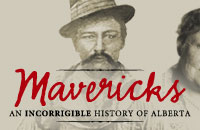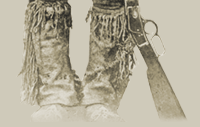 |

[ Project Plans | Essential
Questions | Knowledge Hunt | Glossary
| Links ]
Putting Pen to Paper in the Trenches
Personal Letters and Photographs Detailing the Experience of Living
Through Wartime
Introduction
Students need to gain an understanding of the people and the stories
of Canada and their way of life during major events. Through the
stories and personal histories of the Mavericks, history will be
brought to life as students share information, values and attitudes
about historical personalities and events. What was living in wartime
like? How did it affect individuals and their families? What were
some of the roles Alberta took on when Canada went to war? How did
people communicate with their friends and family during these times?
Project Explanation
In this project, students will develop an appreciation of the social
history surrounding individuals living during wartime. Students
will research a wartime Maverick and write a personal letter home
from that person's individual perspective. They will also find and
write about photographs that illustrate the experiences they are
writing about.
Alberta Social Studies Curriculum Unit Connections
Grade Four - Alberta: The Land, Histories and Stories
4.2 The Stories, Histories and People of Alberta
Grade Five - Canada: The Land, Histories and Stories
5.2 Histories and Stories of Ways of Life in Canada
Materials and Resources Needed
Procedures
Students will create a personal letter home written from the perspective
of one of the War and the Homefront Mavericks in Mavericks: An
Incorrigible History of Alberta. They will also include photographs
as "snapshots" that will help the readers understand their
situation and what they are going through.
Primary historical artifact letters may be used to introduce the
project. The letters of Colonel James Farquharson Macleod to his
wife Mary Macleod are contained in an online exhibit by the Glenbow
museum, and cover the years 1874 to 1894. The above site allows
viewers to examine the original letters or read the transcripts.
To view, open the drop-down mane and click on a year. They may then
view the original or examine another letter by clicking the side
arrows at the bottom of the page. These letters will provide examples
for students about how letters were written in the past, how much
we can learn from them, and how they can be even considered artistic
in form.
In order to take on the role of one of the Mavericks, students
must learn about and research the life of Samuel Steele, Fred McCall,
Mary Dover or Gordon Nakayama. They will use the Mavericks: An
Incorrigible History of Alberta site other web resources, or
encyclopedias to find out about the person and what their life may
have been like at a certain point in time during their war experience.
They will also need to locate information on the specific battles
or war that the Maverick was involved in.
Using the ImagesCanada.ca website, students will find and
use appropriate photographs or "snapshots" of the Maverick
to send home with their letter. The photographs may accompany the
letter as an additional source of information, or the letter may
specifically be about what is happening in the photo. Using the
photos may help them to describe their clothing, where they are,
the experience, their story, and even their thoughts and emotions.
Once they know their character, students will use the ImagesCanada.ca
websites to search for primary photographs to assist and represent
aspects of their letter. Some tips on using the Images Canada web
site:
- Combine search terms to narrow results. The term "war"
alone will yield 2461 matches but, for example, try "parade
war" instead. This will provide 33 photos.
- Just the name can be used in a single search. Searching "samuel
steele" yields 20 photos, "fred mccall" yields
49 photos, and "mary dover" yields 16 photos.
- Click on "more information" under each picture to
find other subject terms to use in searching.
- Photos may be copied into another program like Word and then
enlarged or printed in a landscape format if needed.
All images can be reproduced, in print and/or digital format,
for non-commercial, educational purposes. The images must
not be altered or manipulated in any way and proper credit must
accompany the images. See link below for more information.
http://www.imagescanada.ca/r1-230-e.html
When writing the letter, students should try to stay in character
and make the letter look like it would have been written in the
time and place they intend. For example, the letters of Col. MacLeod
were handwritten, as there were no computers yet. They will have
to decide upon the recipient of the letter, whether it is to their
family, wife or husband, children, a relative, or a friend. Students
should think about where and when they are writing, what was happening
around them, what they might be worried about, what happened during
that day, what kind of small story they could tell, and even what
they would say to their family to put their minds at ease? Students
could even express their Maverick's attitude to war by writing a
poem or a song about what they are experiencing.
Assessment and Evaluation
- Students and their teacher should develop their own rubric by
identifying evaluation criteria for the project that will match
their own learner outcomes. This allows students to understand
the expectations for their work and to have input into the ongoing
evaluation process.
- Students may use their rubric as a guide for writing a self-assessment
of their project work. They will determine their level for each
of the categories and use the criteria specified in their rubric
to justify them.
- After completing the project, students may talk or journal about
what they felt they did very positively, what they had difficulty
with, and how they would change how they would approach a similar
project in the future.
Ideas for Enriching this Project
- Students could recreate their own photograph of a situation
one of the mavericks participated in. They would have to plan,
create costumes and the background, and pose for the photographs
that illustrate some aspect of their life during the writing of
the letter.
- The photos could be imported into a paint or draw program, such
as Kidpix. The students could then "draw" in their own
backgrounds or items such as a plane flying in the background.
- The students could read the letter and share the photos as the
Maverick character themselves, reading it "in person"
to their classmates.
 |



![]()
